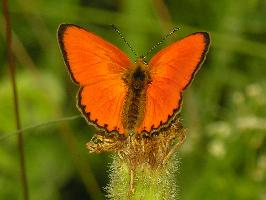
Poids et mesures
| Longueur | de 17 à 20 mm |
|---|
Description de l'animal
The Scarce Copper, scientifically known as Lycaena virgaureae, is a striking species of butterfly that belongs to the Lycaenidae family, which is known for its small size and brightly colored wings. This particular species exhibits a remarkable palette of colors that make it a fascinating subject for both amateur nature enthusiasts and professional entomologists.Adult Scarce Coppers display a significant sexual dimorphism, meaning males and females have distinctly different appearances. Males boast a brilliant, fiery orange on the upper side of their wings, bordered by a thin, dark line and punctuated with small, black spots. This vivid coloring serves as a visual warning to predators about the butterfly's potential unpalatability, a common trait among many species within the Lycaenidae family. The underside of the male's wings is a lighter orange with a pattern of black dots surrounded by white halos, providing excellent camouflage against predators when the butterfly is at rest.
Females, on the other hand, have a more subdued coloration, with wings that are primarily a duller orange or even a coppery brown, adorned with dark spots and bordered by a more pronounced series of black markings. Their underside mirrors that of the males but is generally lighter and more grayish in hue, blending seamlessly into their natural surroundings.
The Scarce Copper is a medium-sized butterfly, with a wingspan ranging from 30 to 38 millimeters. It is found across a variety of habitats, including flowery meadows, woodland clearings, and grassy hillsides, from lowlands up to alpine environments. This species has a preference for sunny, open areas where its larval food plants, mainly species of sorrel (Rumex) and dock (also Rumex), thrive. These plants serve as the primary food source for the Scarce Copper's caterpillars, which are green with a dark line down their back and lighter lines along their sides, allowing them to blend in with the leaves they feed on.
The Scarce Copper undergoes a complete metamorphosis during its life cycle, which includes the stages of egg, larva (caterpillar), pupa (chrysalis), and adult. The females lay their eggs singly on the underside of the leaves of the host plants. After hatching, the caterpillars feed on the leaves, growing until they are ready to pupate. The chrysalis is formed on the ground or among plant debris, where it remains camouflaged until the adult butterfly emerges.
This species is multivoltine, producing several generations a year, with adults typically flying from late spring to early autumn, depending on the altitude and climate of their habitat. During this time, they can be seen actively feeding on the nectar of a wide variety of flowers, contributing to the pollination of many plant species.
Despite its name, the Scarce Copper is not necessarily scarce but can be locally abundant where conditions are favorable. However, like many butterfly species, it faces threats from habitat destruction, agricultural intensification, and climate change, which can lead to local declines in population. Conservation efforts aimed at preserving natural habitats and promoting biodiversity are crucial for ensuring the survival of the Scarce Copper and countless other species that rely on similar environments.
Nouvelles photos d'animaux
Top 10 des animaux
- Dolphin gull (Leucophaeus scoresbii)
- Diana monkey (Cercopithecus diana)
- Moustached guenon (Cercopithecus cephus)
- Galápagos tortoise (Geochelone nigra complex)
- Russian tortoise (Testudo horsfieldii)
- Japanese macaque (Macaca fuscata)
- Stone loach (Barbatula barbatula)
- Greek tortoise (Testudo graeca)
- Common flying dragon (Draco volans)
- Colossal squid (Mesonychoteuthis hamiltoni)